The all-cap growth style ranks fifth out of the twelve fund styles as detailed in my Style Rankings for ETFs and Mutual Funds report. It gets my Neutral rating, which is based on aggregation of ratings of two ETFs and 440 mutual funds in the all-cap growth style as of February 6th, 2013. Prior reports on the best & worst ETFs and mutual funds in every sector and style are here.
Figure 1 ranks from best to worst the two all-cap growth ETFs and Figure 2 shows the five best and worst-rated all-cap growth mutual funds. Not all all-cap growth style ETFs and mutual funds are created the same. The number of holdings varies widely (from 18 to 2021), which creates drastically different investment implications and ratings. The best ETFs and mutual funds allocate more value to Attractive-or-better-rated stocks than the worst, which allocate too much value to Neutral-or-worse-rated stocks.
To identify the best and avoid the worst ETFs and mutual funds within the all-cap growth style, investors need a predictive rating based on (1) stocks ratings of the holdings and (2) the all-in expenses of each ETF and mutual fund. Investors need not rely on backward-looking ratings. My fund rating methodology is detailed here.
Investors seeking exposure to the all-cap growth style should buy one of the Attractive-or-better rated mutual funds from Figure 2.
Get my ratings on all ETFs and mutual funds in this style on my free mutual fund and ETF screener.
Figure 1: ETFs with the Best & Worst Ratings
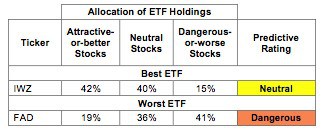 * Best ETFs exclude ETFs with TNAs less than $100 million for inadequate liquidity.
* Best ETFs exclude ETFs with TNAs less than $100 million for inadequate liquidity.
Sources: New Constructs, LLC and company filings
Figure 2: Mutual Funds with the Best & Worst Ratings – Top 5
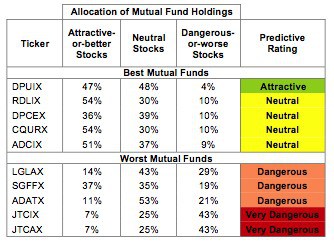 * Best mutual funds exclude funds with TNAs less than $100 million for inadequate liquidity.
* Best mutual funds exclude funds with TNAs less than $100 million for inadequate liquidity.
Sources: New Constructs, LLC and company filings
iShares Russell 3000 Growth Index Fund (IWZ) is my top-rated all-cap growth ETF and earns my Neutral rating. Strategic Funds, Inc: Dreyfus US Equity Fund (DPUIX) is my top-rated all-cap growth mutual fund and earns my Attractive rating.
First Trust Multi Cap Growth AlphaDEX Fund (FAD) is my worst-rated all-cap growth ETF and earns my Dangerous rating. John Hancock Funds II: Technical Opportunities Fund (JTCAX) is my worst-rated all-cap growth mutual fund and earns my Very Dangerous rating.
Figure 3 shows that 455 out of the 2093 stocks (over 33% of the market value) in all-cap growth ETFs and mutual funds get an Attractive-or-better rating. However, none of the two all-cap growth ETFs and only one out of 440 all-cap growth mutual funds (less than 1% of total net assets) get an Attractive-or-better rating.
The takeaways are: mutual fund managers allocate too much capital to low-quality stocks and all-cap growth ETFs hold poor quality stocks.
Figure 3: All-cap Growth Style Landscape For ETFs, Mutual Funds & Stocks
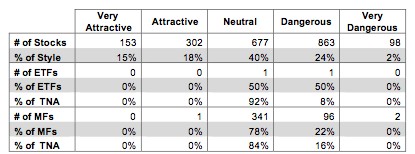 Sources: New Constructs, LLC and company filings
Sources: New Constructs, LLC and company filings
As detailed in “Cheap Funds Dupe Investors”, the fund industry offers many cheap funds but very few funds with high-quality stocks, or with what I call good portfolio management.
Investors need to tread carefully when considering all-cap growth ETFs and mutual funds, as no ETFs and only one mutual fund in the all-cap growth style allocate enough value to Attractive-or-better-rated stocks to earn an Attractive rating. Investors should focus on buying their own baskets of Attractive-or-better-rated stocks.
World Acceptance Corp (WRLD) is one of my favorite stocks held by all-cap growth ETFs and mutual funds and earns my Very Attractive rating. WRLD has grown after-tax cash flow (NOPAT) by 20% compounded annually for the last 14 years. Its return on invested capital (ROIC) has been above 20% for the last six years and currently stands at 22%. Despite this consistent profitability and growth, WRLD is valued at only ~$77.30/share, giving it a price to economic book value ratio of 0.8. This ratio implies that the market is expecting a permanent 20% decline in NOPAT for WRLD. Such a decline seems unlikely for a company that has not experienced a decline in NOPAT decline since the 1990’s.
Pennsylvania Real Estate Investment Trust (PEI) is one of my least favorite stocks held by all-cap growth ETFs and mutual funds and earns my Very Dangerous rating. REITs are trendy right now (just look at how CBS stock took off when it announced the conversion of its outdoor advertising unit to an REIT), but very few of them justify the hype. PEI has not managed to earn an economic profit since 2003. Last year itsNOPAT declined by 54%. Despite this fact, it is valued at ~$18.74/share. This valuation implies a 15% compounded annual growth in NOPAT over the next 13 years. Investors should be wary of betting on such growth. That kind of growth requires the real estate market to bounce back pretty strongly, too strongly if you ask me.
Figures 4 and 5 show the rating landscape of all all-cap growth ETFs and mutual funds.
My Style Rankings for ETFs and Mutual Funds report ranks all styles and highlights those that offer the best investments.
Figure 4: Separating the Best ETFs From the Worst Funds
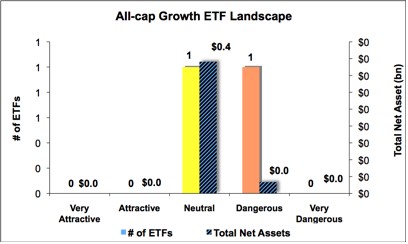 Sources: New Constructs, LLC and company filings
Sources: New Constructs, LLC and company filings
Figure 5: Separating the Best Mutual Funds From the Worst Funds
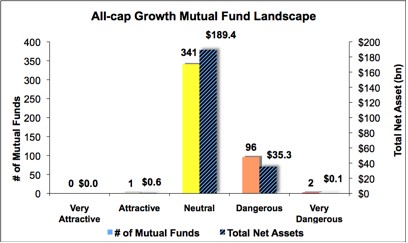 Sources: New Constructs, LLC and company filings
Sources: New Constructs, LLC and company filings
Review my full list of ratings and rankings along with reports on the two ETFs and all 440 mutual funds in the all-cap growth style.
Sam McBride contributed to this report.
Disclosure: David Trainer and Sam McBride receive no compensation to write about any specific stock, sector or theme.
